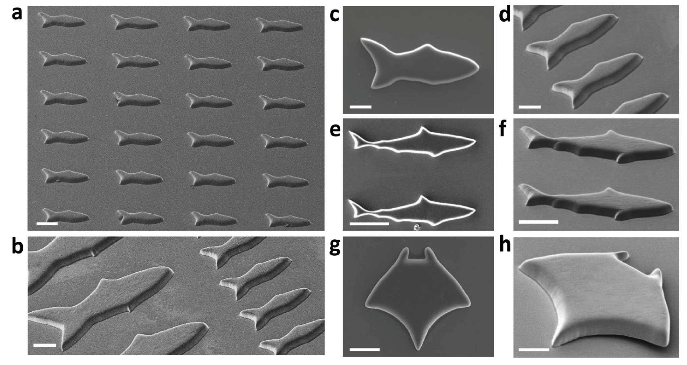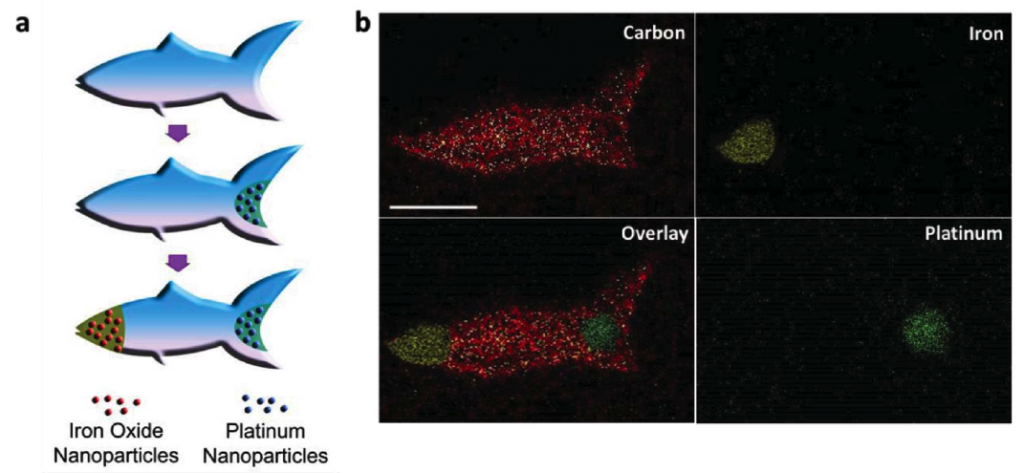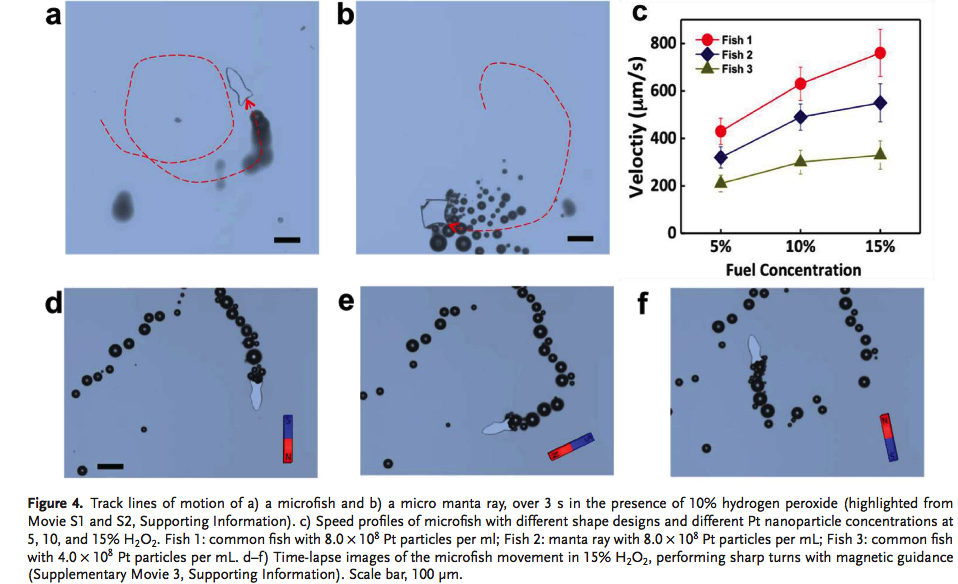 Many futurists envision a time in the not too distant future where we will all have tiny little microbots swimming within our bloodstreams, protecting us from toxins, notifying us of problems and seeking out harmful diseases and pathogens, destroying them on the spot. Certainly we have a long way to go before the medical community adopts such technologies, but we are indeed headed in this direction.
Many futurists envision a time in the not too distant future where we will all have tiny little microbots swimming within our bloodstreams, protecting us from toxins, notifying us of problems and seeking out harmful diseases and pathogens, destroying them on the spot. Certainly we have a long way to go before the medical community adopts such technologies, but we are indeed headed in this direction.
In fact, a recent paper published in Advanced Materials, called “3D-Printed Artificial Microfish‘, details research conducted by the Department of NanoEngineering at the University of California, San Diego, that could further the development of such microscopic robots, enabling directed drug delivery within the human body as well as other applications such as rapid environmental decontamination.
While currently there are numerous methods which have been used to create nanobots for a variety of purposes, the authors note that for the most part these robots consist of inorganic materials and are incredibly simplistic in shape, leaving them incapable of sophisticated functionality. Therefore they’ve set out to create more complex nanobots, which they call microfish, for their ability to swim through biological and non-biological liquids.
To do this, they’ve developed a form of nanoscale, rapid 3D printing they call microscale continuous optical printing (µCOP).

Assorted SEM images of the microfish. a) A uniform array of microfish. b) Microfish of various sizes and c–h) fabricated fish of different designs: fish, shark, and manta ray, respectively. Scale bar, 50 µm.
“The µCOP technology offers efficient fabrication speeds, provides improved feature resolution, and requires no harsh chemicals for fabrication,” write the researchers. “To 3D print artificial microfish with high-fidelity shapes and structures in an economical and scalable manner, we optimized this µCOP system to construct freely swimming microfish composed of poly(ethylene glycol) diacrylate (PEGDA)-based hydrogels and functional nanoparticles as a proof of concept.”
With this 3D printing method, they are able to fabricate robotic microfish using three different types of functional nanoparticles including iron oxide, which can be magnetically guided; platinum, which can be chemically guided; and polydiacetylene (PDA) which can be used for neutralizing harmful toxins. By 3D printing the microfish structures, they are able to significantly customize the nanobots to suit their intended purpose.
The microscale continuous optical printing (µCOP) relies on a digital micromirror device (DMD) chip, with approximately 2 million micro-mirrors which are able to project UV light onto a photopolymer material, curing it one layer at a time, similar to the way the DLP SLA 3D printing process that you may be familiar with works. This enables the microfish to be fabricated in various shapes (manta ray, shark, etc) which measure an incredibly tiny 120 microns long x 30 microns thick. Best of all, these microfish are able to be fabricated in just seconds.
“Optimizing the swimming performance of microswimmers requires precise control over their shape and size,” explain the researchers. “Our µCOP platform is capable of building a wide array of complex 3D geometries, allowing for efficient iteration through various microswimmer designs.”
Researchers are able to mix other nano materials with a PEGDA resin, such as magnetic iron-oxide as well as catalytic platinum. In the experiment detailed in this paper, they were able to print the iron oxide into the heads of the microfish, and the platinum into the tails, thus allowing them to precisely control the movement of the fish. By using hydrogen peroxide, they can create a chemical reaction with the platinum nanoparticals, which then act as a fuel to propel the fish. The magnetism of the iron-oxide allows for steering. Based on the geometry of the printed microfish, along with the amount of hydrogen peroxide used, researchers were able to control the speed at which the fish swam through the liquid
The PEGDA material they use to print the hydrogel structures has been shown to be incredibly stable in shape, while holding the iron-oxide and platinum nanoparticles in place. Researchers have been able to coax the fish into swimming for up to 2 hours within the peroxide solution, and say that the fish can be stored at room temperature for up to a week before use.
Although this paper centers around iron-oxide and platinum for the control of the movement, other nanoparticles could also be used as fuel, including Ag, Ir, MnO2, and catalase, and next the researchers plan to utilize the microfish’s surrounding environment such as water or biological fluid as a fuel source.
Certainly this work could have major implications within the medical field as well as other interesting areas. Let’s hear your thoughts on this amazing work in the 3D Printed Microfish forum thread on 3DPB.com. The paper was authored by Wei Zhu, Jinxing Li, Yew J. Leong, Isaac Rozen, Xin Qu, Renfeng Dong, Zhiguang Wu, Wei Gao, Peter H. Chung, Joseph Wang and Shaochen Chen
Subscribe to Our Email Newsletter
Stay up-to-date on all the latest news from the 3D printing industry and receive information and offers from third party vendors.
You May Also Like
3D Printing Unpeeled: New Arkema Material for HP, Saddle and Macro MEMS
A new Arkema material for MJF is said to reduce costs per part by up to 25% and have an 85% reusability ratio. HP 3D HR PA 12 S has been...
3D Printing News Briefs, January 20, 2024: FDM, LPBF, Underwater 3D Printer, Racing, & More
We’re starting off with a process certification in today’s 3D Printing News Briefs, and then moving on to research about solute trapping, laser powder bed fusion, and then moving on...
3D Printing Webinar and Event Roundup: December 3, 2023
We’ve got plenty of events and webinars coming up for you this week! Quickparts is having a Manufacturing Roadshow, America Makes is holding a Member Town Hall, Stratafest makes two...
Formnext 2023 Day Three: Slam Dunk
I’m high—high on trade show. I’ve met numerous new faces and reconnected with old friends, creating an absolutely wonderful atmosphere. The excitement is palpable over several emerging developments. The high...

































